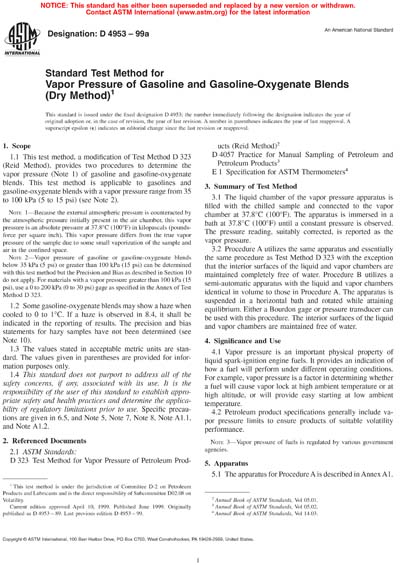Historical
ASTM D4953-99a
Standard Test Method for Vapor Pressure of Gasoline and Gasoline-Oxygenate Blends (Dry Method)
1.1 This test method, a modification of Test Method D323 (Reid Method), provides two procedures to determine the vapor pressure (Note 1) of gasoline and gasoline-oxygenate blends. This test method is applicable to gasolines and gasoline-oxygenate blends with a vapor pressure range from 35 to 100 kPa (5 to 15 psi) (see Note 2).
Note 1-Because the external atmospheric pressure is counteracted by the atmospheric pressure initially present in the air chamber, this vapor pressure is an absolute pressure at 37.8°C (100°F) in kilopascals (pounds-force per square inch). This vapor pressure differs from the true vapor pressure of the sample due to some small vaporization of the sample and air in the confined space. Note 2-Vapor pressure of gasoline or gasoline-oxygenate blends below 35 kPa (5 psi) or greater than 100 kPa (15 psi) can be determined with this test method but the Precision and Bias as described in Section 10 do not apply. For materials with a vapor pressure greater than 100 kPa (15 psi), use a 0 to 200 kPa (0 to 30 psi) gage as specified in the Annex of Test Method D323.1.3 The values stated in acceptable metric units are standard. The values given in parentheses are provided for information purposes only.
1.4 This standard does not purport to address all of the safety problems, if any, associated with its use. It is the responsibility of the user of this standard to establish appropriate safety and health practices and determine the applicability of regulatory limitations prior to use. Specific precautions are given in 6.5, and Notes 4, 6, 7, A1.1, and A1.2.
ASTM International [astm]

